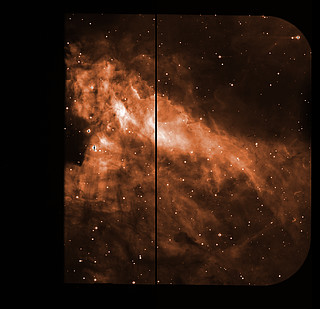EMMI
ESO Multi-Mode Instrument
At the time, EMMl was the first optical instrument for astronomical observations that offered a choice of wide-field imaging (taking a picture over a large area), long-slit spectroscopy (where the light from an extended object such as a planetary nebula is viewed one slice at a time and sent to a prism-like device), low and medium resolution spectroscopy, multi-object spectroscopy and echelle spectroscopy (which uses a special type of diffraction grating to disperse the light), with the capability to switch from one to the other in a matter of seconds. Only the Hubble Space Telescope offered a similar broad choice of observational capabilities.
EMMI consists of over 100 000 individual parts and has two arms, allowing astronomers to observe targets in either blue or red light. Over the years, EMMI has contributed to many amazing discoveries, such as the existence of a complex cosmic mirage in the southern constellation of Crater (The Cup). This gravitational lens system consists of (at least) four images of the same quasar as well as a ring-shaped image of the galaxy in which the quasar resides — known as an Einstein ring. The system was first detected while EFOSC2 was still mounted on the ESO 3.6-metre telescope, and EMMI acquired the necessary spectra to see what was happening.
 In 2008, EMMI also helped to create a beautiful colour-composite image of the nebula that surrounds the Cepheid variable star RS Puppis. Cepheid stars exhibit very characteristic variations in brightness and these can be seen travelling through the nebula as the light is reflected back to us from different layers of the nebula forming a light echo. From EMMI’s images of the light echoes, Kervella et al. (2008) calculated that its distance from Earth was around 6300 light-years.
In 2008, EMMI also helped to create a beautiful colour-composite image of the nebula that surrounds the Cepheid variable star RS Puppis. Cepheid stars exhibit very characteristic variations in brightness and these can be seen travelling through the nebula as the light is reflected back to us from different layers of the nebula forming a light echo. From EMMI’s images of the light echoes, Kervella et al. (2008) calculated that its distance from Earth was around 6300 light-years.
Although EMMI was retired in April 2008, its legacy lives on as its archived data is still constantly used by astronomers around the world, helping us to further our knowledge — EMMI is gone, but not forgotten!
Click here for an ESO movie all about EMMI.
Science highlights with EMMI
- New observations indicate that the asteroid Lutetia is a leftover fragment of the same original material that formed the Earth, Venus and Mercury (eso1144)
- New portrait of the Orion Nebula’s glistening watercolours (eso0925)
- The celestial whirligig (eso0707)
- Maverick comet splits during dramatic outburst (eso9601)
|
Raw image of the Omega Nebula This raw image, straight from the instrument, was used, together with many others, to produce the colour photo further up this page. The images taken with astronomical instruments are always monochromatic: the information on the colours is obtained by taking exposures through different glass filters. The thick black line cutting the field is the gap between the two CCD detectors in the camera. The centre of the brightest stars appears black, as the light saturated the detectors. |
EMMIThe authoritative technical specifications as offered for astronomical observations are available from the Science Operation page.
|


